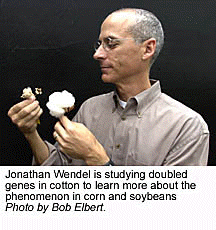Inside Iowa State
November 17, 2000
Iowa's largest cotton farmer
by Brian Meyer
 Jonathan Wendel looks closely at a visitor to his office.
He remarks how the visitor reminds him of someone else on
campus in a similar job. Then he muses on common traits that
people in this type of job might share.
Jonathan Wendel looks closely at a visitor to his office.
He remarks how the visitor reminds him of someone else on
campus in a similar job. Then he muses on common traits that
people in this type of job might share.
That, in a nutshell, is how Wendel's mind works.
The evolutionary biologist has spent years making genealogical connections among cotton species. He adds branches to cotton's family tree -- information that may lead to improvements in Iowa corn and soybeans.
"I work on the coolest stuff," said Wendel, picking up a cotton boll lying on his desk. "Each fiber you see is a single cell. Incredible. Nothing in nature matches it."
The botany professor points to a map that identifies cotton- producing counties in the United States. A tiny section of central Iowa has been shaded by hand.
"I'm the largest cotton farmer in Iowa," Wendel said. His "farm" is the Pohl Conservatory on top of Bessey Hall, where he tends several wild relatives of cotton, gathered from around the world.
The world has 50 species of cotton. Some are dingy, scraggly specimens compared with the pristine puffball of modern cultivated cotton. Others are as coarse as a Brillo pad compared to the satiny feel of today's fibers.
As a University of North Carolina graduate student, Wendel conducted research on Japanese camellias. But he was intrigued by two botanical mysteries surrounding cotton.
One was how cotton was domesticated. Around 4,000 to 5,000 years ago, cotton was domesticated in four separate regions of the world. "This multiple, parallel domestication was accomplished by people with no understanding of biology," Wendel said. "How did it happen? Were the same kinds of genes domesticated time and again?"
The second mystery involved a genetic reunion. Five to 10 million years ago, cotton split into two separate groups. The two kinds of cotton spent a few million years evolving in isolation, one in the Americas and the other in Africa and Asia. Then, 1 to 2 million years ago, an Old World seed somehow made it to the New World.
Wendel pauses. "We're not sure how the seed crossed the Atlantic. It didn't float because it would sink like a stone. But I have this constipated duck theory. . ." he begins, then laughs.
The two kinds of cotton hooked up again to become a polyploid, a plant with double the number of genes. The result of the reunion was several new species, including one that has become the most important cultivated cotton grown today.
Corn and soybeans share a similar history, Wendel said. They are polyploids, too. Little is known about how becoming a polyploid affects a crop.
"All of a sudden, a plant has twice the normal number of genes," Wendel said. "How do doubled genes co-exist in the nucleus? Are many simply redundant? Do some, finding themselves freed from their housekeeping roles, take on new functions? These are the kinds of questions we're asking. What we learn about cotton will apply to corn and soybeans."
Wendel has received funding from the Plant Sciences Institute to study the importance of polyploidy, using cotton as a model. He is comparing doubled genes in polyploid cotton to their nondoubled counterparts in ancestral cotton. Wendel uses molecular technologies to calculate genetic differences among cotton species. These differences can help establish an evolutionary time line.
"If we understand the genealogy, then we can go after the genes themselves. The genes that turn this" (he holds up a wizened boll of wild cotton) "into this" (he holds up a robust modern boll).
Wendel is one of five principal investigators with the Cotton Genome Center, a National Science Foundation-funded program headquartered at the University of California, Davis. Using new genomic information, he is tracing the evolutionary events that permitted the development of modern cotton. The information will be used in the search for key genes that control growth and development of cotton fiber.
The golden age of biology is now, Wendel said. "With all this new genomic information, I feel like I'm in a tropical forest, turning over rocks and discovering new beasts. Every plant has a story."
Wendel also coordinates training programs for the center, so graduate students and postdoctoral fellows can learn more about plant genomics and bioinformatics.
Wendel has traveled the world to study and collect cotton species. He discovered a new species in northwest Australia. "We were riding in a helicopter at the time, and we spotted it because its flowers were so huge," he said.
Wendel teaches Botany 306, a plant taxonomy course. ("Some students call it Botany 30666 because it's so tough," he laughed.) "One hope is to enhance students' awareness of where food and fiber come from. So when they're walking along the salad bar or putting on their clothes, they know the origins of these products."
Iowa State homepage
Inside Iowa State, inside@iastate.edu,
University Relations Revised
11/16/00
Copyright © 1999-2000, Iowa State University, all rights
reserved
URL:
http://www.inside.iastate.edu/2000/1117/cotton.html